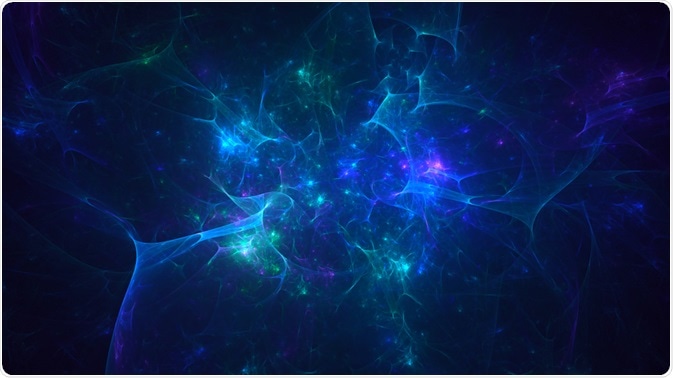2D NMR Spectroscopy: Fundamentals, Methods and Applications
Nuclear magnetic resonance (NMR) spectroscopy was developed to detect protons, and has since then been applied in studying the molecular structure of proteins, RNA, DNA complexes, and interactions between these molecules.
 betibup33 | Shutterstock
betibup33 | Shutterstock
Fundamentals of 2D NMR
2D NMR differs from 1D NMR by the acquisition stage being separated from the excitation stage. The stages in between these are called evolution and mixing. The evolution sequence lets nuclei precess freely, during which time the magnetization is labeled. The mixing sequence sees this magnetization transferred to another nucleus. Lastly, during detection, the magnetization is labeled by a chemical shift of the secondary nucleus.
Data acquisition occurs in waves at specific time points until there is sufficient data for a 2D Fourier transform analysis acting in both directions to yield a spectrum with the evolution frequency and the acquisition frequency.
The resulting spectrum is typically shown as a topographic map. There are several methods of transfer of magnetization, such as COSY, when transfer is measured via bonds to the same class of nucleus and HSQC, when transfer is measured via bonds to a different class of nucleus.
2D NMR: Methods
The NOESY method
One of the major applications of 2D NMR spectroscopy is the NOESY method, used to determine the spatial structure of biomolecules. For example, several NOESY spectra cross peaks, which are the result of interactions between different nuclear spins, can indicate several close hydrogen atoms as in globular proteins or double helical nucleic acids.
This information can be used to infer the presence of loops when paired with sequence-specific resonance assignments. Statistical models can be employed to find arrangements of the sequence that are in congruence with the distance constraints.
COSY methods
2D correlation spectroscopy (COSY) methods can show spin systems within a molecule that are coupled, and through this mechanism the protons can be identified. Information from a COSY spectrum is seen based on coupled or single peaks, and has been used in metabolomics to profile metabolites, even those in low abundance. COSY spectra are also often used for determination of protein structures.
HSQC
Heteronuclear single quantum coherence (HSQC) experiments are slightly different from COSY and NOESY experiments because it is heteronuclear rather than homonuclear. This relates to how well resolved the spectral data is, which in turn relates to how long it takes to acquire the data.
In HSQC methods, magnetization moves from the proton to an NMR active nucleus (such as those of 13C or 15N), and then back to the proton for more sensitive data acquisition. While this improves sensitivity, it only detects nuclei belonging to certain isotopes of certain elements.
Applications of 2D NMR
The main advantage of 2D NMR spectroscopy compared to 1D spectroscopy is that it uncovers signals that are overlapping in 1D NMR spectroscopy due to similar resonant frequencies. It can be applied to a variety of biomolecules, most notably to metabolites and proteins.
2D NMR spectroscopy can be applied to determine concentrations of metabolites, depending on the method used. Heteronuclear experiments such as HSQC are not used to determine concentration, at least not directly. However, HSQC can be used to accurately profile metabolites at low concentrations of just a few micromolar.
Homonuclear methods such as TOCSY can be used to target selected metabolites to generate spectra containing only the metabolite of interest. For example, this method has been applied to show changes in tumor cells that shift from normal to immortalized and to identify associated biomarkers.
A popular application of 2D NMR spectroscopy is for studying molecular dynamics. Once lines in the NMR spectra have been identified, intramolecular interactions can be linked to specific locations in the structure. This can then be used to produce a map of the molecule’s internal mobility patterns.
Molecular dynamics 2D NMR spectroscopy, when applied to proteins, can show amino acid side chains. These can be indicative of both loose ends protruding into the solvent or mutually interacting spatial arrangements, which means that for a protein in solution to be characterized properly the core and flexible surface areas must both be carefully described.
Sources
- Wütrich K. (1985). NMR with proteins and nucleic acids. Europhysics News. https://doi.org/10.1051/epn/19861701011
- Schirra H.J. (1996). Why 2D NMR? http://www.cryst.bbk.ac.uk/PPS2/projects/schirra/html/2dnmr.htm
- Van Q.N. (2013). Current NMR Strategies for Biomarker Discovery. Proteomic and Metabolomic Approaches to Biomarker Discovery. https://doi.org/10.1016/B978-0-12-394446-7.00006-6
Further Reading
- All Nuclear Magnetic Resonance (NMR) Content
- Future of NMR Spectroscopy
- NMR in Cancer Research: An Overview
- Applications of In-Cell NMR
- NMR-Based Metabolomics
Last Updated: Aug 20, 2019

Written by
Sara Ryding
Sara is a passionate life sciences writer who specializes in zoology and ornithology. She is currently completing a Ph.D. at Deakin University in Australia which focuses on how the beaks of birds change with global warming.
Source: Read Full Article
